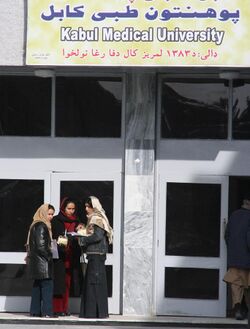Organization:Kabul Medical University
(Pashto) دکابل طبی علومو پوهنتون Da Kābul Tebbi Olomo Pohantūn (Dari) دانشگاه علوم طبي کابل -Dāneshgāh e Olom e Tebbi Kābul | |
 | |
| Type | Medical school |
|---|---|
| Established | 1932 (self-autonomous) University in 2008) |
| Students | 2,970 |
| Location | , , Afghanistan |
| Nickname | پوهنتون طبي کابل |
| Website | www.kmu.edu.af |
kabul University of medical science(Pashto د کابل طبي پوهنتون / Dari: پوهنتون طبي کابل) formerly known as Kabul Medical Institute) is located in Kabul, Afghanistan on the campus of Kabul University. The medical institution was initially maintained by collaboration with the Turkish and French sponsors. KMF developed into a single autonomous University in 2005. It currently graduates professionals in fields of Curative Medicine, Pediatric, Stomatology, Dental and Nursing. All subjects are taught in Dari and Pashto but most medical terms are in English.
Currently, more than 25 medical schools are known to exist in Afghanistan but KMU is known to be the top leading medical school in the country.
Summary of development
- In 1932 Medical School was established as first core higher education institution.
- In 1980 Faculty of pediatric and faculty of Stomatology added to the medical school and the name of medical school change to the State Kabul Medical Institute.
- In 2004 it promoted to Kabul Medical University.
- In 2005 pediatric faculty was dissolved.
- In 2005 faculty of nursing was established.
- In 2010 faculty of public health was established.
- In 2011 faculty of allied health was established.
- In 2015 community college was established.
- In 2016 Kabul Medical University was promoted to Kabul University Medical Sciences .
Establishment of Medical Faculty (1932-1945)
According to the need of the country for modern medicine and attention of King
M.Nader Sha for medicine, on Sunday 22 march 1931 at 3:00 PM meeting of cabinet was held at Delgosha palace and was decided to establish medical faculty in Darulaman palace.
First stage: Affiliation with Turkey from 1932-1945
From the date of establishment Turkey had cooperation with Kabul Medical Faculty. First chancellor of this institute was Dr.Rafiq Beg (Turkish) then Dr.Hassan Reshad Beg (Turkish) was the chancellor. Finally Dr.Zahidi Beg (Turkish) was appointed to this position. During this period, this faculty had seven graduates.
Second stage
Affiliation of Kabul Medical school with France from 1946-1955
- In 1945 Peerbolanzha was appointed as the chancellor of Kabul Medical Faculty.
- During this period Kabul Medical Faculty had 10 graduates.
- Kabul Medical Faculty developed and implemented general rules for teaching and examinations.
Third stage: Kabul Medical Faculty from 1956-1978
- Dr. Faqir Mohmmad Shefa appointed as the voice chancellor of Kabul Medical Faculty and in 1956 Dr. Mohammad Usman Anwari appointed as the first chancellor of Kabul Medical faculty
- A bylaw was determined for teaching and learning.
- Blood bank was established.
- Female students was enrolled in this period.
- More Afghan lecturers were employed according to regulations.
- Publication of Kabul Medical Faculty was developed and text books were published in Persian.
Forth stage Kabul Medical Faculty from 1978-1991
- Promotion of Kabul Medical Faculty to governmental Kabul Medical Institute of Abu Ali Sina Balkhi.
- Bachelor degree upgraded to Master Degree.
- Kabul Medical Institute joined to Ministry of Public Health
- Library of the institute became more equipped and a modern printing press center was established and equipped by the cooperation of WHO.
- Change of six year period of education to seven years by re-entry of PCB.
Fifth stage: Kabul Medical Institute of Abu Ali Sina Balkhi from 1992-1996
- In 1993 due to Civil war the facility of Ministry of Public health and four hundred beds hospital which was administrative facilities and practical work facilities was available for this institute
- In 1995 Kabul Medical Institute moved to its main place and reconstruction of Kabul University of Medical Sciences took place.
Sixth stage: Kabul Medical Institute from 1997-2001
- Kabul Medical Institute separated from Ministry of Public health and joined to Ministry of Higher Education.
- In this period female students were not allowed to study in this faculty.
Seventh stage: Kabul Medical institute from 2001 up to now
- In 2004 promoted to Kabul University of Medical Sciences
- In 2005 pediatric faculty was dissolved.
- In 2005 faculty of nursing was established.
- In 2010 faculty of public health was established.
- In 2011 faculty of Allied health was established.
- In 2015 community college was established. In this year Kabul University of Medical Sciences was officially recognized by medical b
- In 2016 Kabul Medical University was promoted to Kabul University Medical Sciences .
Up to the beginning of the 1980s, Afghan Medical Schools were under Kabul University and the Ministry of Education; however, after Russian occupation, all Medical Schools came under the jurisdiction of the Ministry of Public Health and later on the Ministry of Higher Education.
During the days of the Taliban, women were not allowed to study medicine at Kabul Medical University, not even under the cover of the burka.[1]
The University of Manitoba's medical school along with University of Nebraska Medical Center helped the Kabul Medical University rebuild its library after the war. University of Nebraska Medical Center provided KMU with scholarships for KMU lectures and students as well as provided it with up-to-date medical technology and research based institutions like Cardiac Research Center. Manitoba put together a basic collection of 672 medical textbooks.[2]
In 2007 Kabul Medical University cooperated with the King Edward Medical University of Lahore Pakistan in training students.[3]
References
External links
[ ⚑ ] 34°31′0″N 69°7′47″E / 34.516667°N 69.12972°E

